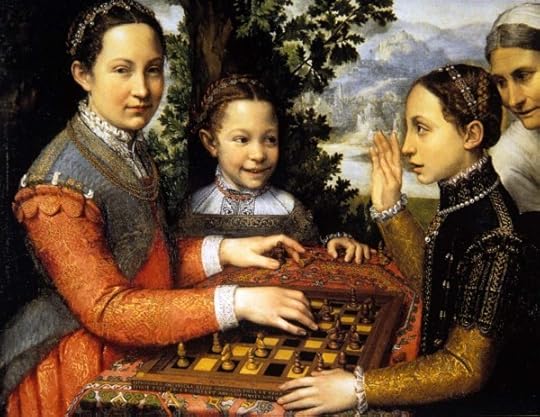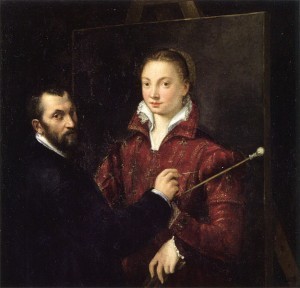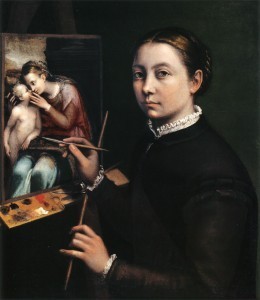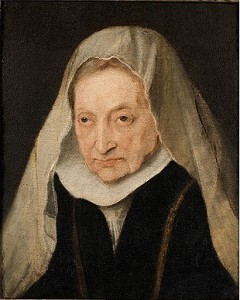A game at chess

In a Renaissance garden, Lucia, Minerva, and Europa Anguissola play at chess. They delight in one another, in the game. Look at the mischief in that little one’s face! She knows what her sister, all innocence, is up to. The eldest looks out at us, half smiling: she holds some broader strategy in mind. She is born to govern. And the old servant (much loved: she appears in other canvases) looks not at her nurselings but at the board. She sees the mate.
Their sister who painted them has signed the edge of the chess board: Sophonisba Angussola Virgo.
There were six Anguissola sisters—almost a Pleiades—and a little brother, Asdrubale. As the children of a cultured Lombard nobleman, they lived in a little academy, an ivory tower. Oh yes, those clothes are gorgeous, and the hills beyond the garden dreamlike—but it’s the tutelage I envy. They were given masters in music, in languages (that imp Minerva would become a writer and a Latin scholar), and in art.
All of the sisters painted. Lucia, the mistress of the chess game, was brilliant but died young; Anna Maria and Europa gave up their art upon marrying; Elena became a nun. Sofonisba, evading the great scythe, the garland, and the veil, outshone them all. Giorgio Vasari wrote of her: "Anguissola has shown greater application and better grace than any other woman of our age in her endeavors at drawing; she has thus succeeded not only in drawing, coloring and painting from nature, and copying excellently from others, but by herself has created rare and very beautiful paintings.”
At eighteen, she painted her drawing-master painting herself. (Couldn’t decide where that arm should go.)

By 23 or 4, she looks out from her easel, in modest command. Close-braided, sober-clad, she has put off her red and gold with her mastery. Virgo: a woman in control of her own life.
In two years, Elizabeth I will ascend the throne.

At 27, Anguissola became the court painter to Philip II of Spain and Elisabeth of Valois. Her work was much admired.
After her childbearing years had passed, she chose two husbands: her first at 39, overruling Philip II’s match for her. At 47, widowed recently and sailing homeward to Cremona, she met a much younger man, “the captain of the ship on which she was traveling.” They married and lived happy ever after in a household with a room of her own. “A great love,” he wrote of her.
A privileged life. Serene. Unlike the struggles of so many women artists, far unlike the storm and glare and blood of Artemisia Gentileschi’s later times. No chiarascuro in her history, but a clear light, humanist. No drama. But within the narrow confines of her rule-bound (inlaid) life, she played brilliantly. She studied the board.
Sofonisba lived a very long time, from the later Renaissance into the Baroque. As a young woman, she studied with Michelangelo; as a young man, van Dyck came to see her in Palermo, to pay his respects to the old master, Michelangelo’s last student. Doubtless she gave him good advice. He painted her at 92: still sharp, still powerful. A White Queen on the board.

Nine
Published on June 15, 2012 01:44
No comments have been added yet.
Greer Gilman's Blog
- Greer Gilman's profile
- 42 followers
Greer Gilman isn't a Goodreads Author
(yet),
but they
do have a blog,
so here are some recent posts imported from
their feed.



